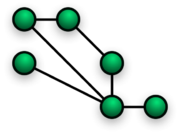- Mesh topology
-
Topologie mesh
La topologie mesh (terme anglais signifiant maille ou filet), est une topologie de réseau qualifiant les réseaux (filaires ou non) dont tous les hôtes sont connectés de proche en proche sans hiérarchie centrale, formant ainsi une structure en forme de filet. Cela permet d’éviter d’avoir des points sensibles, qui en cas de panne, coupent la connexion d’une partie du réseau. Si un hôte est hors service, ses voisins passeront par une autre route.
Cette architecture est issue de la recherche militaire et a été utilisée par les armées notamment américaine et française.
C’est une technologie de rupture comparée aux solutions centralisées classiques sans-fil avec station de base. Les solutions « Mesh » autorisent un déploiement rapide et simplifié, une grande évolutivité de la couverture et, de par leur maillage, une forte tolérance aux pannes et aux interférences, réduisant significativement les coûts d’installation et d’exploitation des réseaux. Ces solutions reproduisent l'architecture de l'Internet tout en l'optimisant pour le sans-fil.
L’implémentation d’une telle topologie est appelée réseau maillé.
Sommaire
Standard OLSR
Les spécifications du standard international « Mesh » OLSR (Optimized link state routing protocol - RFC 3626) de l’Internet Engineering Task Force (IETF) ont été produites par l’INRIA (Institut de Recherche renommé en France) dans le cadre ouvert du groupe de travail MANET (Mobile Ad hoc NETwork) de l’IETF.
OLSR permet de plus le maintien de la connectivité avec une montée à l'échelle du nombre de hôtes en mobilité, la compatibilité avec différentes technologies radio (Wi-Fi, WiMax, …) et filaires (PLC, fibre, Ethernet) du fait de son positionnement au niveau IP (Internet Protocol) ainsi que l'optimisation en sans fil mobile, Peer-to-Peer (P2P) & Machine-to-Machine (M2M). OLSR est déjà prouvé sur le terrain exigeant et disponible commercialement. Le « Mesh » 802.11s, encore en période d'essai de l'IEEE, est limité au WiFi, sans montée à l'échelle et mobilité. Il prévoit l'implémentation d'OLSR en option.
Standard batmand
un autre protocole mesh dérivé d'olsr
Standard babel
http://www.pps.jussieu.fr/~jch/software/babel/draft-chroboczek-babel-routing-protocol-01.html
standard très prometeur
Linux
Le noyau Linux intègre depuis la version 2.6.26 (sortie le 13 juillet 2008) le support réseau en topologie mesh. La technologie nécessite cependant du temps pour être réellement exploitée pour une utilisation générale.
Voir aussi
- Portail de l’informatique
Catégories : Réseau sans fil | Topologie de réseau
Wikimedia Foundation. 2010.

